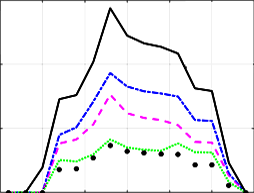Accuracy of evaluation of speech transmission index with formant-modulation method
DOI:
https://doi.org/10.3103/S073527272306002XKeywords:
assessment accuracy, speech transmission index, formant method, formant-modulation method, modulation methodAbstract
Unlike the known modulation method, the formant-modulation method for the evaluation of speech intelligibility allows the evaluation of not only the speech transmission index but also the articulation index. This paper presents the results of a study of the accuracy of speech transmission index evaluation using the full and rapid variants of the formant-modulation method. The study is carried out by the computer simulation method for two cases, namely, the case of the predominant effect of noise interference and the combined effect of noise and reverberation in a room of medium volume. Dependences of the systematic and random components of the estimation error of speech transmission index on the duration of the test signal and signal-to-noise ratio are obtained. It is shown that although the fast version of the formant-modulation method is 4–5 times inferior to the full version in terms of measurement accuracy of the speech transmission index, the desired estimation accuracy can be achieved if the duration of the test signal is sufficiently long. In particular, the bias and standard deviation of the estimate of the speech transmission index obtained by the fast formant modulation method do not exceed 0.03 and 0.014, respectively, for the test signal duration of 16 s.
References
- M. A. Sapozhkov, Speech signal in cybernetics and communication, [in Russian]. Moscow: Svyazizdat, 1963.
- J. Keränen, P. Larm, V. Hongisto, “Simple application of STI-method in predicting speech transmission in classrooms,” in Joint Baltic-Nordic Acoustics Meeting 2004, 2004, uri: https://www.akustinenseura.fi/wp-content/uploads/2013/08/o27.pdf.
- H. Steeneken, T. Houtgast, “Basics of the STI measuring method,” in Past, Present and Future of the Speech Transmission Index, Soesterberg: TNO Human Factors, 2002.
- “British Standard BS EN 60268-16. Sound system equipment. Part 16. Objective rating of speech intelligibility by speech transmission index,” 2011.
- A. Prodeus, “On possibility of advantages join of formant and modulation methods of speech intelligibility evaluation,” in 2010 Proceedings of VIth International Conference on Perspective Technologies and Methods in MEMS Design, 2010, uri: https://ieeexplore.ieee.org/document/5499260.
- A. M. Prodeus, L. B. Dronzhevska, V. A. Klimkov, D. A. Shagitova, “Formant and formant-modulation estimation methods intelligibility of speech. Part 1. Unification of algorithms,” Electron. Commun., vol. 15, no. 6, pp. 117–124, 2010.
- L. B. Dronzhevskaya, V. A. Klimkov, A. M. Prodeus, D. A. Shagitova, “Formant and formant-modulation estimation methods intelligibility of speech. Part 2. Accuracy and speed of measurements,” Electron. Commun., vol. 16, no. 6, pp. 16–24, 2012, doi: https://doi.org/10.20535/2312-1807.2011.16.6.240403.
- A. Prodeus, “Rapid version of a formant-modulation method of speech intelligibility estimation,” in Perspective Technologies and Methods in MEMS Design, 2011, uri: https://ieeexplore.ieee.org/document/5960269.
- M. Jeub, M. Schafer, P. Vary, “A binaural room impulse response database for the evaluation of dereverberation algorithms,” in 2009 16th International Conference on Digital Signal Processing, 2009, pp. 1–5, doi: https://doi.org/10.1109/ICDSP.2009.5201259.
- J. S. Bradley, R. Reich, S. G. Norcross, “A just noticeable difference in C 50 for speech,” Appl. Acoust., vol. 58, no. 2, pp. 99–108, 1999, doi: https://doi.org/10.1016/S0003-682X(98)00075-9.
- P. Zhu, F. Mo, J. Kang, “Experimental comparison between direct and indirect measurement methods for the objective rating of speech intelligibility,” in Proc. The 21st International Congress on Sound and Vibration (ICSV 21), 2014.
- D. D’Orazio, E. Rossi, M. Garai, “Comparison of different in situ measurements techniques of intelligibility in an open-plan office,” Build. Acoust., vol. 25, no. 2, pp. 111–122, 2018, doi: https://doi.org/10.1177/1351010X18776431.
- J. Kotus, B. Kostek, A. Kurowski, P. Szczuko, “A comparison of STI measured by direct and indirect methods for interiors coupled with sound reinforcement systems,” in 2018 Joint Conference - Acoustics, 2018, pp. 1–6, doi: https://doi.org/10.1109/ACOUSTICS.2018.8502277.
- P. Zhu, W. Tao, F. Mo, F. Guo, X. Lu, X. Liu, “Experimental comparison of speech transmission index measurement in natural sound rooms and auditoria,” Appl. Acoust., vol. 165, p. 107326, 2020, doi: https://doi.org/10.1016/j.apacoust.2020.107326.
- A. M. Prodeus, M. V. Didkovska, “Fourth moment and its functional transformations as seasures of clipping degree and quality of acoustic signal,” Radioelectron. Commun. Syst., vol. 64, no. 5, pp. 255–265, 2021, doi: https://doi.org/10.3103/S0735272721050046.
- D. Byrne et al., “An international comparison of long-term average speech spectra,” J. Acoust. Soc. Am., vol. 96, no. 4, pp. 2108–2120, 1994, doi: https://doi.org/10.1121/1.410152.
- L. Morales, G. Leembruggen, S. Dance, B. M. Shield, “A revised speech spectrum for STI calculations,” Appl. Acoust., vol. 132, pp. 33–42, 2018, doi: https://doi.org/10.1016/j.apacoust.2017.11.008.
- O. Pedchenko, S. Lunova, “Analysis of Ukrainian diagnostic articulation tables,” EUREKA Phys. Eng., vol. 1, pp. 63–72, 2018, doi: https://doi.org/10.21303/2461-4262.2018.00559.
- S. Naida, V. Didkovskyi, O. Pavlenko, N. Naida, “Spectral analysis of sounds by acoustic hearing analyzer,” in 2019 IEEE 39th International Conference on Electronics and Nanotechnology (ELNANO), 2019, pp. 421–424, doi: https://doi.org/10.1109/ELNANO.2019.8783915.
- M. Rujzl, M. Sigmund, “Depersonalization of speech using speaker-specific transform based on long-term spectrum,” Radioengineering, vol. 32, no. 4, pp. 523–530, 2023, doi: https://doi.org/10.13164/re.2023.0523.


